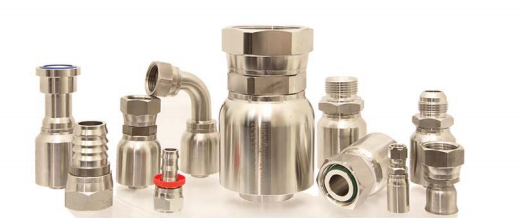Hydraulic Hose End Fittings and Popular Manufacturers

Image text: Hydraulic hose end fittings for hydraulic systems
If you're purchasing hydraulic hoses, the chances are that you're going to need their associated hydraulic hose end fittings or couplings as well. That's because different hoses come in different lengths, diameters, pressure ratings and need to be compatible with the fluid they carry. Fittings help you adapt hoses to your hydrostatic system, allowing you to extend a hose range and attach them to different hydraulic pumping and actuation components.
Materials used for Fittings
Metal:
You'll find that metals are the most common material chosen for manufacturing fittings owing to their durability, strength, and heat resistance. Steel is the most widely used metal as it satisfies the requirements mentioned above, suitable for high-pressure applications. If you're looking for more resistance, then you might want to consider stainless steel variants for fittings. Brass and aluminum are also used to combat chemical resistance but don't have the strength that steel brings. However, you can use them for low to medium-pressure applications. They have the advantage of being inexpensive, allowing you to minimize the cost of hydraulic assemblies.
Plastic:
Plastics will provide the best corrosion resistance; however, they are not as strong or durable as metal fittings. They are the least expensive out of all the fittings but can only be used for low-pressure applications.
Types of Fittings
Permanent Hydraulic Hose Fittings
Reusable Hydraulic Hose Fittings
Factors to Consider When Selecting Hydraulic Hose Fittings
Seal type:
There are many standards like the NPT/NPTF, BSPT, SAE, ISO, DIN, Metric, among others, that define how the fittings get attached to hydraulic components. For example, the NPT/NPTF standard, the most commonly used in North America, outlines that the threads need to be tapered for a strong, leak-proof seal. Make sure you identify which standard fitting is required. You may need to consider flare angles, O-ring type and size, and seat diameter before selecting the appropriate fitting.
Temperature:
The fittings' temperature rating depends on the material the fitting is made out of and the seal type. O-rings also have a temperature rating. If you operate at higher than that temperature, the O-ring deforms, causing leaks around the fitting.
Pressure:
Different fittings are rated for different pressures. Fittings that seal with an o-ring provide a higher pressure rating than metal-to-metal contact fittings, given that the medium they carry is compatible and the operating temperature does not exceed the rating of the O-ring. When tightening fittings, make sure you don't over-torque them, as this may damage the threads and cause leaks.
Media Compatibility:
The medium the hose assembly carries has to be compatible with the fittings you choose. Petroleum or synthetic media can erode o-rings if they're not compatible, causing hydraulic hose failure. Make sure you read all the technical specifications for them before installing them.
Popular Hydraulic Hose Fittings Manufacturers
Parker
Eaton
Gates